Woodstock, 1969. What a time to be alive. In the era of free love and hippies, one of the most legendary music festivals in the whole world took place in New York state. Woodstock holds such a place in music history that even those who didn't attend almost feel like they did.
Luckily for us, there were journalists, documentary makers and directors present to capture everything that was so special about this super famous event. Though you may have seen some of the better-known images of Woodstock, there are some rare gems that really show what was going during that magical time.
Most of us automatically think of the music and the fun, but we bet you hadn't considered the traffic jams, food shortages and general logistical nightmares that the festival entailed. Organizing toilets and other infrastructure for an unexpected 400,000 people couldn't have been easy! Take a look at these rare photos and prepare to be shocked.
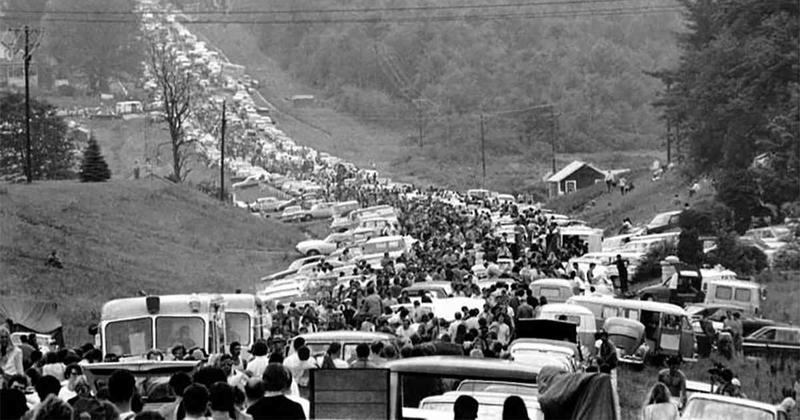
This is what the huge gathering at Woodstock looked like to the artists who were lucky enough to go out and take the stage. It's a swarming mass of humanity that extends out from the front row to the very edges of the horizon. To the performers, it must have been almost overwhelming.

Estimates place the attendance at Woodstock as being in the region of 400,000. That's well on its way to having half a million people in the same place at the same time; more than a lot of towns and even some cities. To give a sense of perspective, even the world-famous Glastonbury Festival in England can only admit around 130,000. The normally small and quiet town of Bethel, New York, must have wondered what hit it. This was more than just a festival. It was a movement!
Ever been stuck in a tailback that just seems to go on forever? Spare a thought for these poor souls. Even with 400,000 people at the festival, many more tried to get there without success. Several eye witnesses said that their desperation was such that a lot just abandoned their cars, got out and walked the rest of the way.

Imagine being completely gridlocked for hours on end, going nowhere, in a queue that went on for so long you couldn't even see the beginning or end of it. In those days there was no such thing as cellphones, so there was little to do to keep yourself entertained and no internet to check for traffic updates. Hopefully the radio was giving out some information. We're guessing people like this guy, who brought a guitar, became popular with commuters just because it gave them some kind of music to watch and listen to when they couldn't reach the event!
There are a lot of musicians who owe at least part of the reputation they enjoy today to performing at Woodstock. Even just being there to perform was a major feather in the cap of a band or singer. But it wasn't just the musicians who found that the event enhanced their star status.

A lot of what we now know about Woodstock is only known because people were there to document the event. One such person was legendary film director Martin Scorsese. Here he is on the right, with the headset, making sure everything is recorded for posterity. Today, he's a legend in the industry with more than 80 Oscar nominations to his name. Back then he was just a young guy trying to make sure that what happened at Woodstock was immortalized on film. The documentary he made of the festival is still considered to be a definitive work.
When you think back to the 1960s, what symbolism comes to mind? If you aren't old enough to remember the 60s, what comes to mind when you try to picture the era? For a lot of people it might be the 'Ban the Bomb' symbol that was spray painted on many a wall, or worn around the neck as a medallion. For others it was the smart suits worn by acts like the Beatles. But for a whole subculture of society at the time, it's tie dye clothing.

Nobody seems to know who started the craze, or why, but it was everywhere you looked at Woodstock, and for a couple of years either side of it. The fashion is strongly associated with hippies, and their message of peace and free love. Unlike modern festivals, there were no merchandise stores at the event, so people like the ones on the stall pictured were free to make money by selling their own designs to a captive audience.
This is a fashion that persists to a greater or lesser degree right up to the modern day. Pretty girls with flowers in their hair are almost a cliched image now - it's part of almost every female festival goers wardrobe and it's even one of the more popular filters on snapchat - but it started at Woodstock.

Two years before the festival, singer-songwriter Scott McKenzie had released 'San Francisco', a song containing the lines 'if you're going to San Francisco, be sure to wear a flower in your hair'. Plenty of the girls heading to New York that weekend decided to follow the advice even though they had a different destination in mind. Something about flower crowns spoke of being a child of nature, and it was a look that anybody could achieve without having to pay for it. Revelers who attend festivals like Coachella probably wish that was still the case today.
One of the many legends told about Woodstock is that not only was it a cultural happening, and a pivotal musical event of the era, it was completely free. It was a free festival for people who were into free love. It's actually a true story, but it was by accident more than by design.

The organizers originally intended to charge for entry - because who would put on a festival of this size and make no money out of it? - but had to abandon that idea when the crowd turned up and swamped the field. There was simply no way to organize that many people into queues to buy tickets, so they had to abandon the attempt and let nature take its course. With no organization it could easily have descended into a riot, but fortunately hippies aren't exactly known for their violent tendencies.
Woodstock would have been one of the greatest experiences and memories of your whole life if you were lucky enough to attend it, but it was just as big a moment for the bands and singers who performed there. Many of them had never performed for a crowd even half this size before, and nor would they ever again, so they had to find time to sit back and drink it in. That's exactly what Jefferson Airplane are doing here. That's lead vocalist Grace Slick sat in the middle, dressed in white.

A total of 33 acts performed over the course of the three days, and we'll look at them in detail a little later on in our list. That may seem like a very low number compared to modern standards, but modern festivals tend to have multiple stages, often divided by genre and interest. Woodstock had only two, and one of these was mostly reserved for non-musical performers.
At the time that the first Woodstock happened in 1969, it was a one off, and people treated it as such. They all headed to the New York area expecting to see a one off show, with no idea how many other people had the same idea, or how huge the event would turn out to be. They came for a concert and left having become a part of history.

Because of the success of the original, a whole series of Woodstock events followed (although the organizers eventually managed to work out the whole 'charging for entry' thing), and the fields that it happened on are almost considered to be hallowed ground for musicians and fans of music. Today, the original site hosts the Bethel Woods Center For The Arts, which opens for musical events and performances all year round. We think the people behind the first event would consider that a pretty good legacy.
Those of you who really know their music will probably know 'Magic Bus' by British rockers The Who. It's something of a classic. The song was released in 1970, and The Who played at Woodstock the year before. As you can see, there was a bus there. We don't know how magical it was - although it looks pretty cool - but we think it's a safe bet the song was inspired by the festival. The bus was apparently a great place to go and find some marijuana.

Although marijuana is illegal, pretty much everyone at Woodstock was smoking it, and you didn't really qualify as a hippie if you didn't. The police took a relaxed attitude toward it, presuming they could even get into the event at all, because not one single person was arrested during the event. There are also no reported incidences of violence whatsoever. We hope there were qualified medical personnel on site anyway, though - two woman actually gave birth at the site.
If you stop take a second to think about it, although 400,000 people is an amazing attendance figure, it brings a lot of difficulties with it, too. We've already mentioned that the organizers had to give up trying to charge people to get in, but that was the tip of the iceberg. You're dealing with a site that contains 400,000 people who all need to eat and drink. You're also dealing with 400,000 people who need to use the toilet. The site just wasn't set up to deal with that kind of demand.

Just about everything ran out. The site was eaten out of food, ran out of water, and bathroom availability was just a non-starter. Fortunately, hippies are great at community building and found some creative answers to some of the problems. We'll get to them later!
Martin Scorsese is a phenomenal film director, and he's achieved everything within the field. However, back in 1969 he was very young, and not as adept as he would go on to be. He also physically couldn't be everywhere at the same time. If you were on the main stage at the same time he was filming, your performance made it onto his documentary, and your profile was boosted worldwide. If you weren't, then even if you were a major act at the time, it's likely that most people don't even know you played Woodstock. That has to be frustrating.

Different performers found themselves impacted by this in different ways. For Joan Baez, the woman in the picture, she became an icon of the festival and forever linked with the event in many people's minds. For Sly and the Family Stone, however, it was as if they'd never played at all even though they were a massive act during the era.
Absolutely everybody had a great time at the festival. The bands loved playing to a crowd that big. The audience loved being played to. The revelers loved being in a huge open community where sex and drugs circulated freely, and nobody wanted to start any trouble. It was the Summer of Love and three days of absolute bliss, where the party never stopped, and nobody went to bed. The only people not enjoying a second of it were the organizers.

As we already know, nobody paid to get in. That means there was no money to pay the bands. Some of the acts, aware of the problem, demanded to be paid in cash before taking the stage. This meant the organizers had to persuade a local bank to open on a Saturday - unheard of at the time - and allow them to withdraw money and pay their performers. If they hadn't have done, the festival would likely have become a complete bust.
Not everybody who lived in the area was exactly thrilled about the festival coming to town. We shouldn't judge them for that - imagine your town, suddenly filled with an additional half a million people screaming, shouting, taking drugs and not washing for three days. It's not unreasonable to be more than a little annoyed by that. The residents of Woodstock hated the idea. And that's why the festival didn't actually happen at Woodstock.

Although Woodstock was the original intended destination, the organizers just couldn't find a suitable candidate for a venue, so they tried to move it to Wallkill. The residents of Wallkill outright refused permission for the festival to be staged within their boundaries, so Bethel got to play host as the third choice. The name 'Woodstock' was kept just because it sounded cooler than Bethel.
When you hear the word 'Glamping' you probably think it's a modern sensation, where people who like the idea of being at a festival but hate the idea of getting muddy turn up in their luxury motor home, with its in-house shower, TV and phone charging accessories. You'd be half right, but the idea that a simple tent just won't do has been around for as long as festivals.

As you can see from the picture below, although there were plenty of normal tents, some people felt that it would be more appropriate to assemble a full sized Indian style wigwam. If you ask us, that's a little over the top. Also note that the tents are just dotted everywhere; any idea of segregation between the camping fields and the performance area went out of the window when that huge crowd turned up, so people just set themselves up wherever they felt like it.
These four guys just had no idea what was about to happen to them. The young men in the picture are Michael Lang, Artie Kornfield (great name for a festival organizer), John P. Roberts and Joel Rosenman. It was the latter two in particular who invested the money to make the event happen. They probably hoped that a good crowd would turn up and things would go swimmingly. They underestimated the public's appetite.

The four were business partners, and actually just wanted to stage a festival to promote their own music studio. They had almost no relevant experience and were completely out of their depth; aside from the rush to the bank, the failure to sell tickets and the venue changing three times, they didn't do anything about building a stage until less than a month before the festival happened. Everything was done last minute in a rush, with fingers crossed and prayers whispered.
Look at this happy looking couple, who were the husband and wife who owned the land Woodstock happened on. He was called Max Yagsur and given the scale of the clean-up job that's happening behind him on his own land, he seems to be taking things remarkably well.

Yagsur was promised that $10,000 would be paid to him in return for the festival using his land. Instead, given the human mass that descended upon them, he was left with $50,000 worth of damages. Despite this, Yagsur maintained a philosophical approach, saying of the festival, 'If we join them, we can turn those adversities that are a problem of America today into hope for a brighter and more peaceful future'. Sadly, Yagsur wasn't long for this world; he died of a heart attack four years after the festival, aged just 53. Rolling Stone magazine honored him with a full-page obituary - rarely awarded to non-musicians.
If health and safety inspectors made it onto the grounds of this festival - that's if health and safety inspectors even existed back then - we're pretty sure they would have unplugged the bands, kicked everyone out and declared the whole area a biohazard. It's not a stretch to say anybody who ate the food on offer at Woodstock was taking their life into their own hands.

Anecdotal reports from the time suggest that chopped vegetables were being served to children from trash cans, which doesn't exactly sound appetizing. Then there was the question of the births. It was difficult for medical teams to even get into Woodstock, let alone reach people deep within the human masses. So, we wonder who helped with the two babies being born, who cleaned them up afterwards, and how the mothers were cared for afterwards. To this day, nobody has ever come forward and admitted to being one of the Woodstock babies.
We know we mentioned the traffic situation earlier on, but we think this picture gives you a better sense of perspective. The buildup issues around Bethel began five entire days before the festival even began. Parked and abandoned vehicles sat fender to fender in every direction from the farm for a distance of twenty entire miles. Local residents couldn't get in or out of their own town. Performers had to get as close as they could and were then brought in by helicopter.

And then, when all's said and done, there's the issue of how to get out. Could you remember where you put your car if you'd abandoned it in an unfamiliar area, and then spent the next three days drinking and taking drugs? Also, a lot of hippies drove the same vehicle. 'Hey buddy, have you seen my car? It's a Volkswagen bus and it's...oh. I see the problem'.
The community spirit and sense of togetherness at Woodstock was a one in a generation happening, and couldn't be replicated. People tried to organize follow up Woodstock events, under the original name, in 1979, 1989, 1994 and 1999. The last of those ended in complete disaster, as violence and riots claimed the festival, resulting in large fires, uncontrolled fights, and absolute anarchy. You could still argue that nobody suffered worse than the original organizers, though.
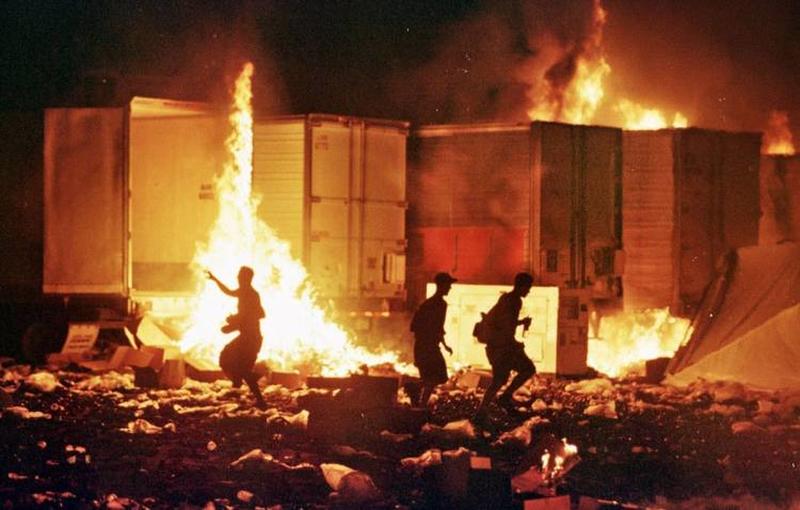
By now, you've probably realized that receiving no ticket money, plus paying the bands in cash, plus having to helicopter the bands in, probably cost a lot of money. You'd be absolutely right. By the end, the four organizers were in debt to the tune of $1.3m. Paying that debt off took them over a decade, and it was mostly done by licensing audio and recording rights from the festival. Thanks for picking up the bill for us, guys. We appreciate it.
Well, this is awkward. One of the many beliefs shared by the majority of festival goers was a dislike for the US military. Like many in society at the time, they believed that the Vietnam War had been going on for far too long, they weren't winning it, and it was time for peace. They also didn't believe in the cause and took issues with soldiers who went to fight for it.

That attitude came back and bit them a little when food, water and medical care ran out, and there was only one organization capable of airlifting the essential supplies in. Yes, you guessed it, the army stepped in and delivered not only the supplies, but many of the festival's performers. Trying to ward off the possibility of festival goers attacking the military aircraft, an announcer took the microphone on the main stage and shouted 'They are with us, man, they are not against us' in order to encourage safe passage.
This had to have been heartbreaking! Imagine being booked to play at Woodstock, seeing and hearing reports of the sheer size of the event, gearing yourself up mentally to take the stage - and then finding out it's just not going to happen for you. You'd be crushed.

Some of the biggest names scheduled to perform at the event weren't able to get there for a number of reasons. John Lennon was refused an entry visa from Canada by the US Government for reasons that were never clear but were believed to be politically motivated. The Jeff Beck Group, in a crazy move, thought it would be appropriate to break up just weeks before the festival. Come on guys, you can't hold it together a little while longer to play the greatest show on Earth? Iron Butterfly probably had the most miserable time of all, because they got trapped at a New York airport.
Here's a question for those of you who've been to a music festival that happens over a weekend. How does the schedule usually work? If you said that bands start on Thursday or Friday night (depending on the festival), carry on throughout the weekend, and end with a crescendo on Sunday night, then you'd be in agreement with 99% of festival organizers. Not so at Woodstock, to the detriment of the legendary Jimi Hendrix.

For reasons that will never make any sense, Hendrix was scheduled to perform at 9am on Monday morning. At that time, those who'd partied through Sunday night were asleep, and many revelers had packed up and started to make their way home. They missed Hendrix performing his now legendary guitar rendition of 'The Star Spangled Banner', which is one of the iconic moments of the entire decade. Who thought this was a good idea?!
Before anybody starts calling the performers on the weekend greedy, let's consider what factors were at work here. Some of the biggest bands in the world were being asked to play at a festival nobody had ever heard of, organized by people with no reputation, at a location that changed three times during the planning stages. The acts were understandably a bit wary of the setup and demanded fees that would make it worth their while to attend.

Jimi Hendrix was paid $18,000 (and put on at 9am on Monday morning - we're not over that), Jefferson Airplane took double their usual fee at $12,000, and The Who, Janis Joplin and the Grateful Dead insisted on being paid up front in cash before they'd agree to appear. Nobody sensible would have gone ahead with this festival.
The people retailing food at the festival were in a unique position. Major name festival retailers - with the kind of experience you'd need to deal with a festival this big - were wary of dealing with the organizers for the same reasons the band were, unimpressed by their lack of knowledge and questionable forward planning. For that reason, a firm called 'Food for Love' were contracted in. 'Food for Love' had never catered for anything even a tenth of the size of Woodstock. It was always bound to end in disaster, but they made it worse.

Seeing that they had a very hungry, captive audience, they jacked up the prices of their hot dogs and burgers from a reasonable 25 cents to a dollar a time. To say that the hippies didn't like this naked capitalism is an understatement. They voted with their hands - and burned the stalls down. The moral victory was theirs, but the food burnt with the shacks.
Now things are getting seriously strange. How do you even begin to contemplate the idea of policing and providing security for half a million people, if you want to keep the police as far away from the venue as possible? The organizers, faced with an unusual situation, went with an unusual solution. They recruited all of the members from a New Mexico hippy commune called the Hog Farm. We guess that makes as much sense as anything.

Known as the 'Please Force' (get it?), they would go around and politely ask people who were up to no good to stop it. Their leader had the interesting name 'Wavy Gravy' and apparently spent the entire weekend walking around dressed as Smokey the Bear. Trouble makers got a custard pie in the face, or a soaking in soda water. The unusual security team saved the day when food ran short, making huge amounts of brown rice and granola and giving it away for free.
New York is a pretty big place, as you'll know if you've ever been there. Millions of people live there, everything's super-sized, people live on top of other people. It's busy. The surge of population to Bethel meant that for the duration of the festival, the small town became the third largest settlement by population in the entirety of New York State. That's a happening. That's a seismic event. That's the greatest festival in the world!
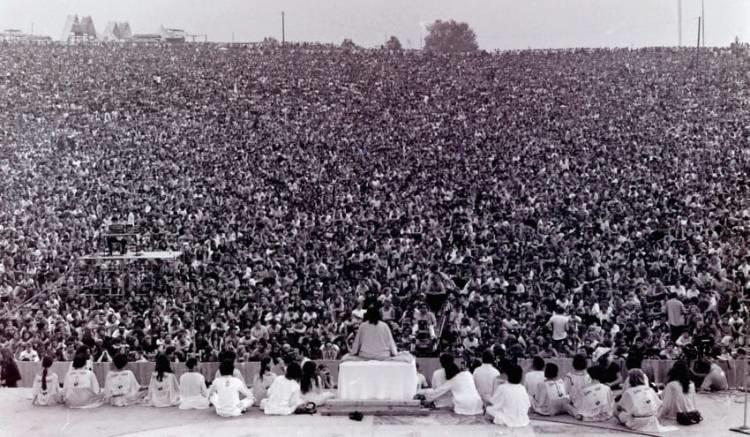
Bethel's Governor Nelson Rockefeller (another great festival name) could have said any of these things and it would have made for a great soundbite, but instead he referred to the festival site as a 'disaster area'. Thanks for being a drag, Nelson. We know you knew the crowd was huge already, we just wanted an excuse to show you another cool photo of it.
Although it was hard to get medical care and attention into the site - until the army intervened - those who were in there were doing their best to see patients and record what happened. The statistics they collected were a little alarming - there were 5,162 recorded medical incidents, which means that over 5% of the entire population suffered an incident requiring medical attention at some point over the three days.
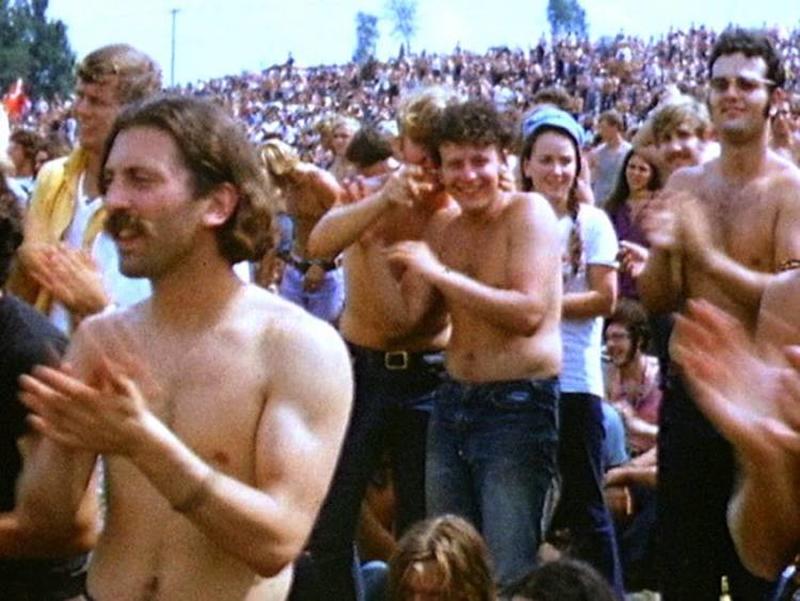
A significant number of these incidents were to attend people who'd had drug issues, including abuse and overdose, and that shouldn't come as a shock to anybody. Sadly, there were also three deaths at the festival. Two people died from overdoses, which is sad but unsurprising, but one festival goer slept in a muddy sleeping bag in a field of debris. A tractor that was trying to tidy up the mess didn't see him and ran over him, resulting in his death. That's no way to go.
One of the great perils of packing to go to a music festival is needing to cover any eventualities. It's usually the height of Summer, so you want shorts, vests, and a light wardrobe. It's also bound to rain at some point, so you need wet weather clothes. You hope and pray that it won't turn into a mud bath, but you need to guard against that as well. That isn't how it used to be. The rain came down at Woodstock, and nobody cared at all.
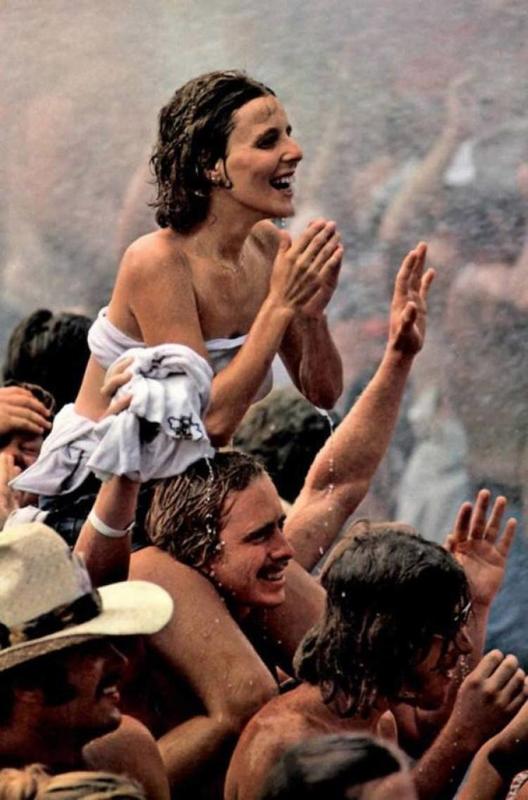
It might be down to the free-spirited nature of the place, but the festival goers seemed to welcome the rain. Nobody changed out of their sunshine outfits, and indeed some people took it as an invitation to take it all off and dance naked. Skinny dipping had been observed in and around the festival, with nobody judging or being judged.
OK, one more 'look at the massive crowd' photo and we're done, we promise. Well, not promise. Maybe we'll do another. But they're really cool! Look at this aerial shot, showing how far the crowd expanded outwards in every direction. The area being covered by humanity here far outreaches the limits of the original festival, which didn't exactly delight the local residents. Attendees were free to roam as far and wide as they wanted - because the fences had been cut down.
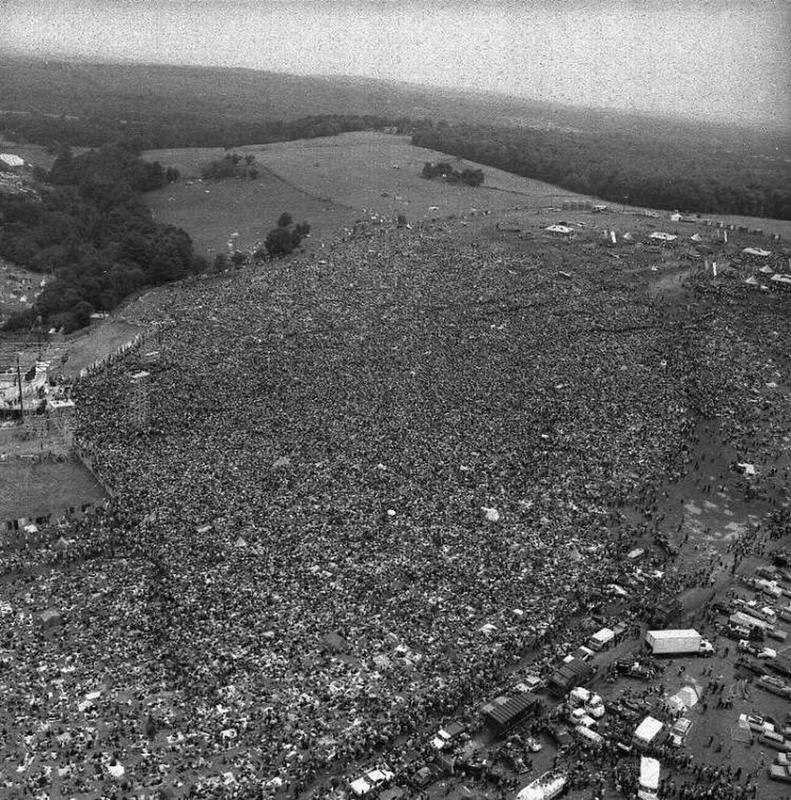
When the crowds arrived for Woodstock and swamped the gates, a decision had to be made. The fences were there to keep people out, and protect the people inside, but people were climbing over them and tearing holes in them, making them unsafe. Eventually, the only thing that could be done was to completely remove them.
You've seen the pictures of tents and wigwams dotted all over the arena, and there's something pleasing about the idea of being able to camp right next to the main stage if you can find a space. But this was a free festival - albeit by accident - and it doesn't stay free if you have to pay money for your living accommodation. So, here's some people who found another way that didn't cost anything!
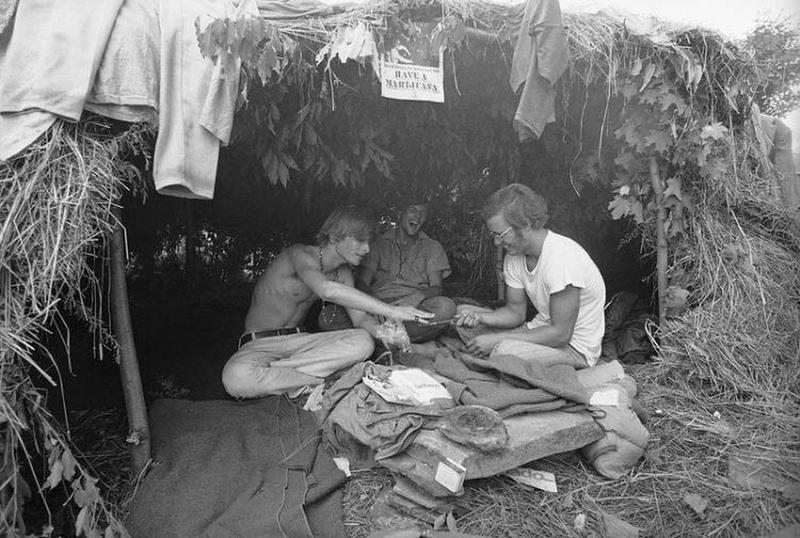
Apparently, sights like this were common. This was a grass hut, built by the people inside it with materials they found on the farmland, and served perfectly well as a base of operations for the weekend. You're not imagining the sign over the door either - grass huts or similar ramshackle constructions substituted for mini shops, which you could visit to buy marijuana or other substances of choice. Never let it be said that hippies weren't creative.
We imagine that choosing where to camp wasn't the easiest process. Half your mind is already busy trying to remember where you abandoned your car, you're surrounded by way more people than you were expected, and the site is filling up fast. You just want to get your tent set up and explore your temporary surroundings, so you're likely to just set things down in the first clear space you can find. And then you have to find it several hours later, in the dark. Possibly whilst high.

The path names laid out by the organizers didn't really help matters. Imagine the conversation. 'Do you remember where we put the tent, man?' 'I don't know, dude, I think it was on High Way. Just off Gentle Path'. 'High Way? Are you sure it wasn't Groovy Way?' 'I dunno man, it could have been Groovy Way, too. I dunno. I'm high'. Perhaps choosing street names that weren't part of everyday hippie conversation might have been a better idea.
The music at Woodstock wasn't limited to the hours that bands and performers were on the stage. The party went on every hour of the day, all around the site. This was a time when a lot of music fans also played music themselves and brought their instruments along with them. If you were any good, you might find you could draw a crowd yourself!

This clarinet and drum combination certainly seem to have the people around them up and dancing, and it looks like there may be a few more instrumentalists just out of shot. Guitars were played around campfires everywhere you moved. Who knows what stars of the future were entertaining crowds of five or ten with songs that they only wrote an hour beforehand? People went to Woodstock to get lost in the music, and the music duly obliged.
In 1969, the spirit of revolution was in the air. The Cold War was in full effect, relations between East and West were strained, the Vietnam War was deeply unpopular at home, and large swathes of the population were simply tired of the old way of doing things. There was an open rebellion against the establishment and conservatism, and the youth seemed to have a deeply liberal agenda on their mind. For a Government terrified of the threat of Communism, Woodstock was an issue.
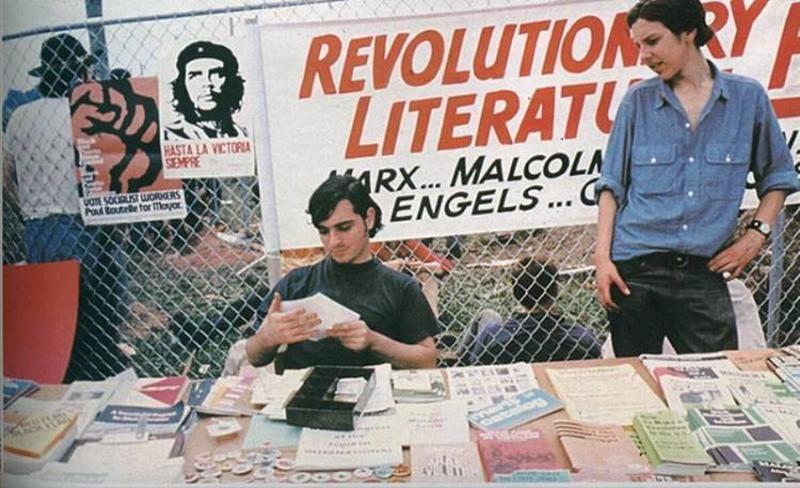
Hippie ideologies often drifted along towards Marxism, and with icons like John Lennon seemingly preaching from the Communist Manifesto, the kids were listening. Woodstock was full of mini stalls like this one, offering free 'revolutionary literature' and organizing support for left wing politicians at forthcoming elections. The Socialist Workers Party were particularly popular, and Che Guevara was hailed as a hero of the Cuban Revolution. For the old guard, it felt like their entire existence was at risk.
At modern festivals, camping areas are often divided up between families and 'night owls' - people who'd rather party without disturbing children and babies who've been brought along. There are even festivals who turn away under 16s completely because they'd rather not have children exposed to the sorts of thing that go on at such gatherings. That wasn't the case at Woodstock.
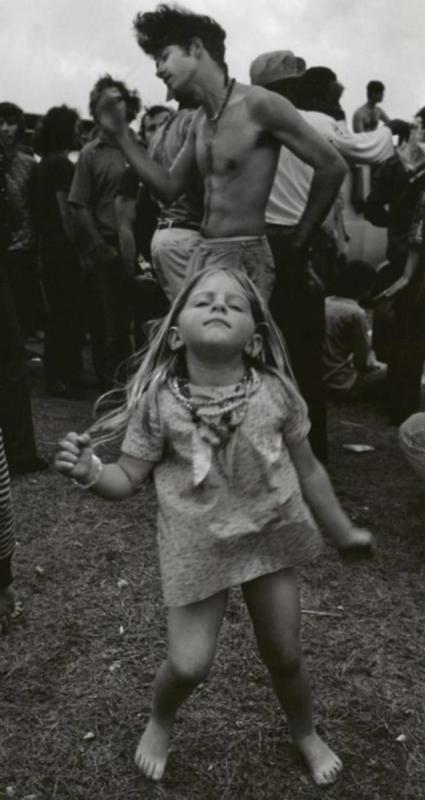
As well as two children being born, little ones came along with their families to share in the experience, and nobody thought it was odd. Adults and children danced together and sat around the same campfires, all joined together by the same sense of community spirit and shared experience. For a whole generation, it was a weekend that formed their whole identity. These were truly the children of the revolution. Everybody at the festival believed that Flower Power was a movement that had started and could never be stopped.
You have to find something to do between watching the bands, and you can't spend all of that time drinking and smoking because you'll eventually pass out and miss something really important. For the ever-resourceful hippies, the land they were on gave them the opportunity to build their own entertainment.
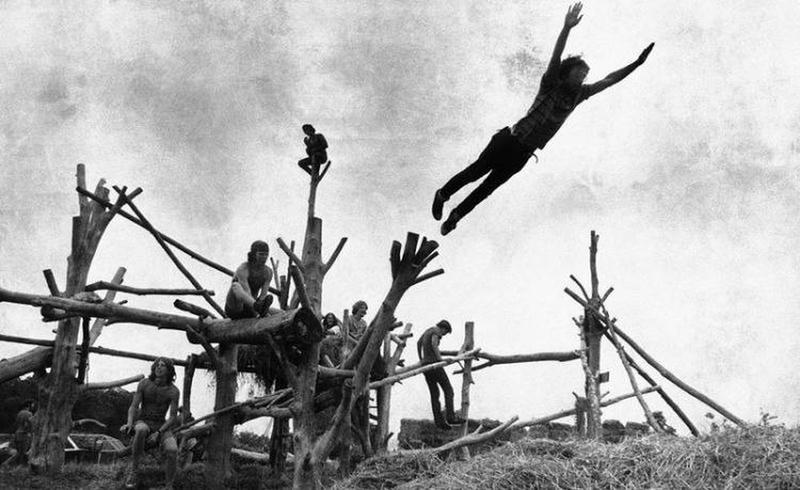
Surrounded by handy wood, thick branches and hay bales, it was easy for those with the ability to build climbing frames and play pens, which were as much fun for the adults as they were for the children, as seen here. We're not sure that modern health and safety executives would have signed off on this construction, but it looks solid enough, and diving headlong into a hay bale must have been fun. We're not so sure about the person stuck on top of that pole though, it looks a little uncomfortable to us!
After a couple of days of heavy partying, surrounded by alcohol, mud and smoke, chances are you were feeling a little sticky, sweaty and smelly. The site didn't have enough toilets, let alone anything resembling a bathroom or shower, so those who remained aware of their hygiene had to get a little creative to wash it all off. Fortunately, nobody at Woodstock had any concerns about nudity. And by that, we mean other people's or their own.

It wasn't an uncommon site to see dozens of people at a time stripping everything off and diving into a stream to wash the mud away. This couple seem to be positively enjoying it. We presume that either the water was a lot warmer than it looked, or they were simply too numbed out to care. Going back to the real world and having to wear your clothes around people must have felt like quite a comedown after such freedom.
There's a lot going on in this picture, so we're going to break it down for you piece by piece. The vehicle in the background, believe it or not, used to be a school bus. Someone's done a lot of intricate painting work on it, and also fitted a sky-dome. Whilst that's quite an achievement, we're not sure what benefit it brings, or why it was necessary. We also don't know whose children are in the picture, but we hope they're not getting involved with what's on the bus.

The man in the hat - and his friends on the bus - are members of the Merry Pranksters. They were members of a commune who followed the works of American counterculture author Ken Kesey, who allowed them to live in and around their homes. Wherever you saw their legendary psychedelic school bus, which was named 'Further or Further', you were welcome to hop on board with them and take some LSD.
The term 'free love' these days is usually interpreted as a reference to sex, especially when connected to the 1960s. It was a time of sexual liberation and experimentation, when contraception became more available and barriers broke down. For some hippies, having sex with complete strangers was as normal as shaking hands with them, and the threat of sexual diseases wasn't yet known or understood.
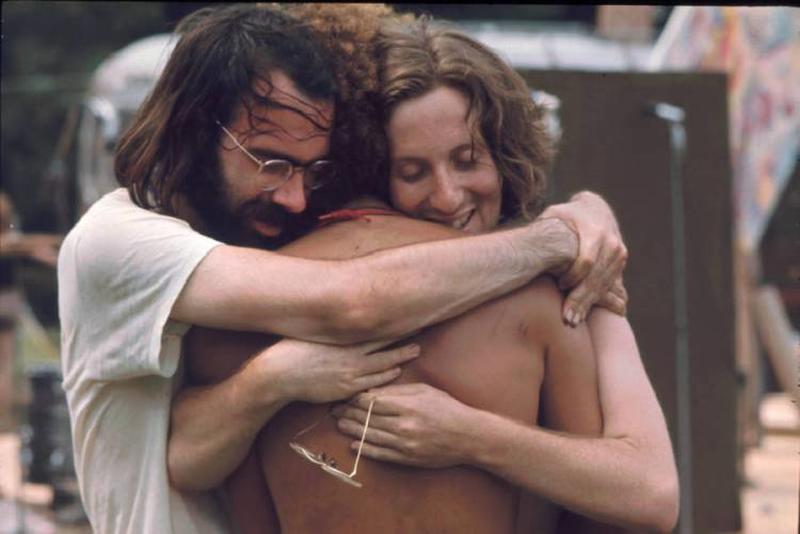
The community at Woodstock definitely loved each other, but that didn't always mean they were taking each other to bed. As seen here, people who'd never seen each other before in their lives would often greet each other with a warm embrace like they were long lost family, accepting them within the spirit of love and universal peace that the festival embodied. Nobody had to feel alone at Woodstock. Everybody was welcome. We imagine the drugs probably helped, all the same.
If you'd completely indulged in the full spirit of the festival - the music, the drink, the drugs, the love and the nudity - there was a fair chance that you may have lost everything you came with. Even if you could remember where your tent was, there was likely nothing in it anymore. This was an era before cellphones, so you couldn't phone a friend for help, and plus you'd only have lost your phone anyway. For a few, 'everything' included the clothes off their back.
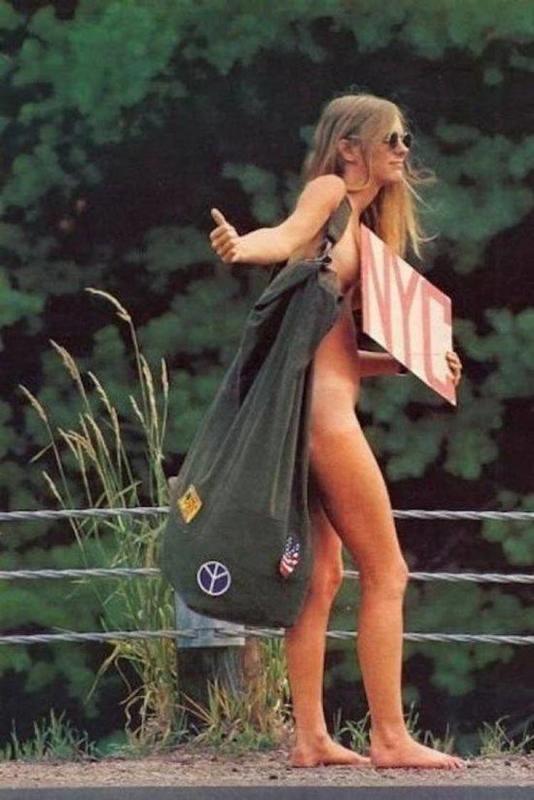
Here's a young girl who clearly decided that stripping down was the way forward, and then either couldn't find or didn't want her clothes when she was done. Now she's stuck on her own without transport or anything to wear, trying to find her way back to NYC. She's managed to keep some of her belongings with her in the bag, but presumably, nothing fit to be worn.
When we talk of multiculturalism today, we usually hear the phrase in the context of division. Watching the news every night can make you feel that we're a world divided by creed, color, and belief. If that's true today, it's a modern invention. It wasn't the case in 1969 at Woodstock, where people from all walks of life sat side by side in peace
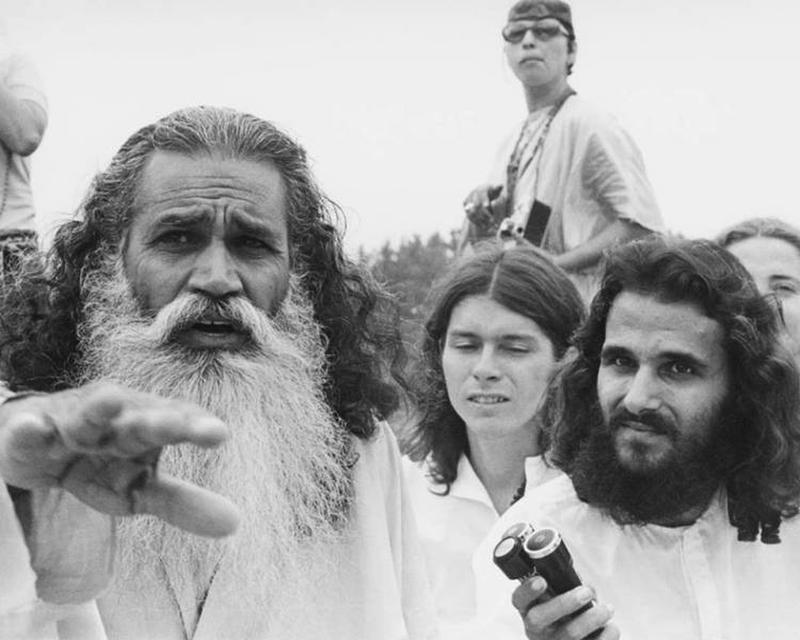
The site played host to Christians, Muslims, Hindus and Buddhists, all of whom had turned up to enjoy the event and share the message of their religion with anybody who wanted to hear it. They didn't fight each other, they didn't cause anybody any problems, and nobody thought anything about it was strange. They were just as much a part of the experience as anybody else, and for a counterculture looking for new systems to believe in as they abandoned their own, they probably found a lot of open minds and ears waiting for them.
The stage times at Woodstock were a little unusual. You're probably used to the headline act of a festival closing a main stage performance somewhere between midnight and 1am. Woodstock had no time for such petty concerns. They had acts to fit in, and they were going to use all the time available to them. That meant major acts starting their sets at pretty crazy times of day. Janis Joplin, for example, didn't even start her Saturday set until 2am. Fortunately, nobody at Woodstock ever wanted to go to sleep.
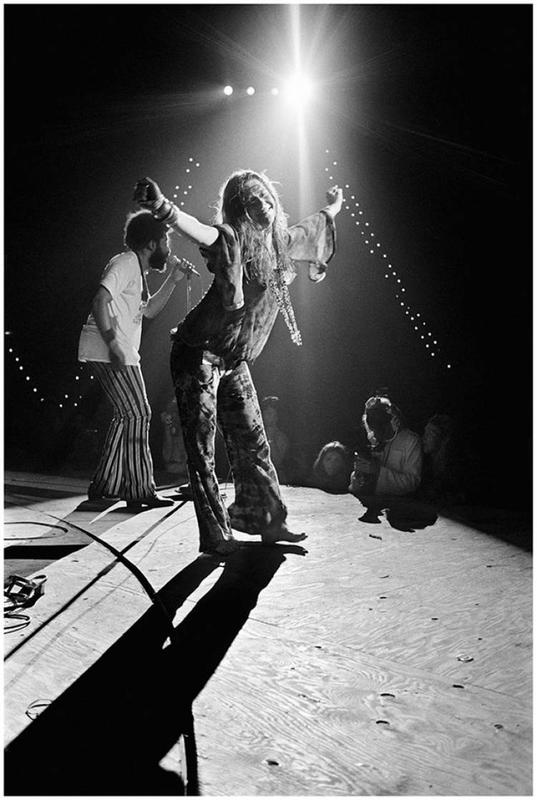
Joplin tore up the stage with a legendary performance, playing a ten-song set that drove the crowd into a frenzy and finishing with her classic 'Ball and Chain'. This photo captures her in her element, clearly enjoying her time to shine. Tragically just one year later she was dead, as her years of drug and alcohol excess caught up with her.
Woodstock was a festival that was in danger of being shut down for every second it stayed open. The overcrowding made it impossible to police, food and water on the site almost completely ran out, hygiene facilities were nowhere to be found and the local Governor viewed the site as a disaster area. It wasn't even clear that some acts could be helicoptered into the site until the day of their performance. And then there was the rigging.
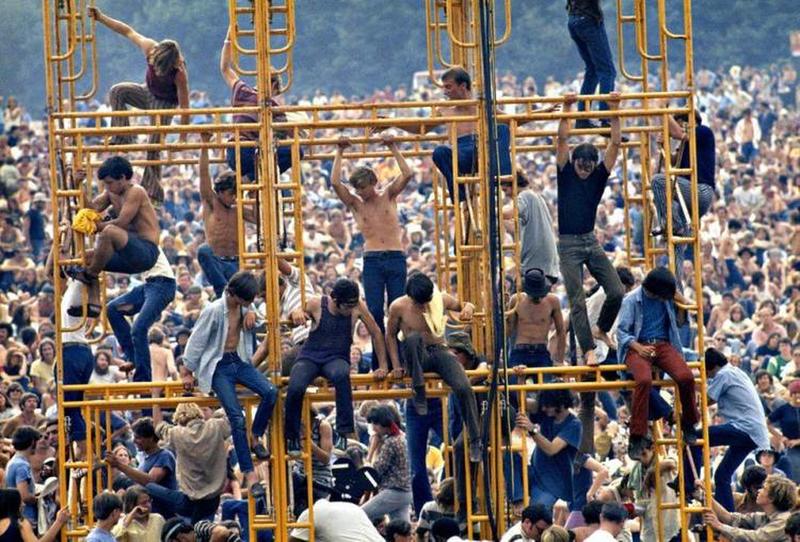
You've probably seen rigging like the yellow structure in the picture at lots of festivals and major gigs. It's usually used to support speakers, lighting rigs, video equipment or whatever is required of it. At this festival, it was mostly used to support people who just wanted to get a better view. Unsurprisingly, it collapsed. What was surprising, though, is that it didn't kill anybody on or underneath it in the process.
When we say that the festival was hosted on a farm, we literally mean a real, working farm. Real, working farms have animals. The animals were moved to a safe distance, but they were probably still a little bemused that there were thousands of people trampling their favorite spots of ground. And that's when they weren't bothering them for milk.

With nothing to eat or drink, people looked to the area around them for solutions, and unfortunately the cows came within range. People started visiting them for milk, and the equation of 400,000 people trying to get milk from a few regular cows doesn't work. Only the first few will have managed to get anything from them, but it didn't stop others trying. We should be glad that nobody decided to cook and eat them.
Now you know why people were just getting naked and jumping into streams. If you wanted to wash yourself within the festival's normal arena, here's what the facilities looked like. It's basically a pipe jammed into the ground with a hosepipe in it, spurting out a pathetic amount of water. You couldn't wash a dog with that, let alone a human.

Most people used it to cool down more than they did to actually clean themselves, although it wasn't bad if you just wanted to give your hair a quick rinse. Unfortunately, the water constantly splattering out onto the ground around it made the surrounding area very muddy, totally defeating the point of the exercise. The man in the picture seems to be rinsing off his feet, which he surely realized was a waste of his time the moment he put them back down again.
Feast your eyes on a world before the internet. It was possible to get news both in and out of the Woodstock site if you were prepared to queue for a long time and make use of the very basic facilities.
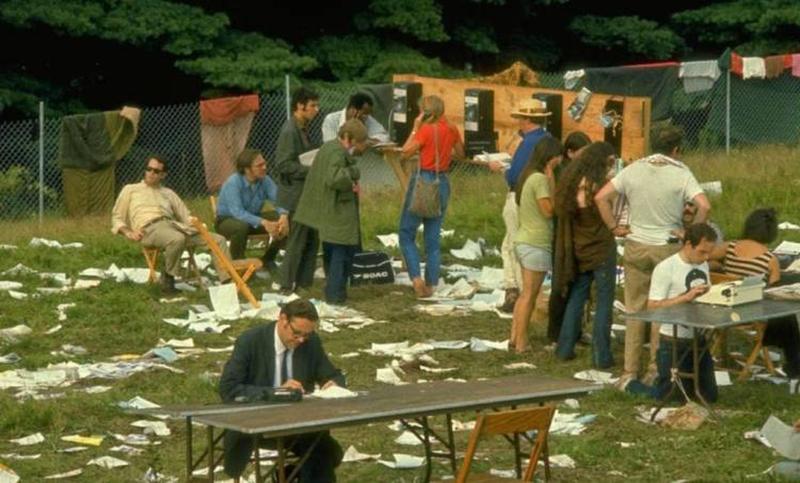
What you're looking at here is twofold. In the background, on the orange wall, are four payphones (one of which is smashed) which attendees could use to call home and reassure their parents that they hadn't died, and that it wasn't as bad as what they were hearing on the news. In the foreground are two journalists, one with a typewriter, summarizing the day's events and getting their stories off to their editors. Unless they brought carrier pigeons, we'd have to assume there was also a fax machine somewhere. You have to admire the dedication of the guy who's worn a full suit and tie to a music festival.
This may have been taking it a little too far, although we salute all of these people for their courage. With the festival oversold, and all the good camping spaces taken, people were forced to camp a little farther away from the action than they'd really like to be. And by that, we mean the nearest clear space they could find was a nearby graveyard.
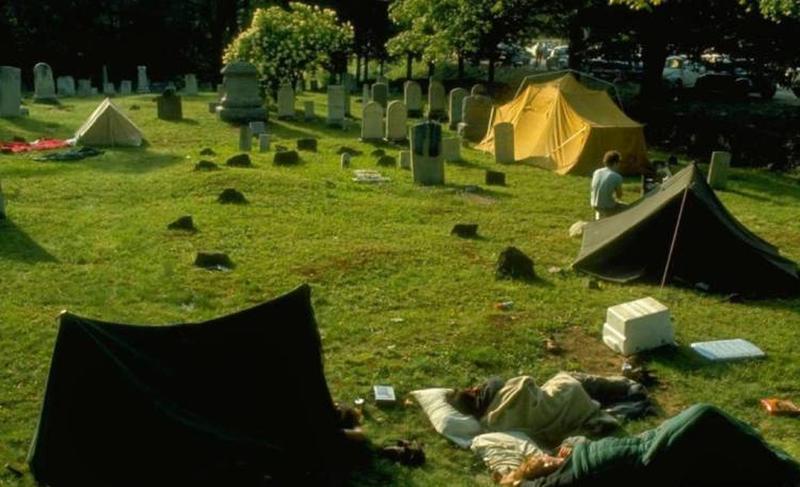
A willingness to sleep with or on top of the dead just to make sure you don't miss out on a festival is to be admired, but we can't help but wonder what these people saw late at night. With a mind full of psychoactive chemicals, in a spooky graveyard, in the dark, anything could have happened. Or maybe they were all just hardy souls who didn't believe in any of that, and so they just got on with it. Either way, we're not sure we'd want to try it out for ourselves.
Take a good, long, look at the beautiful girl in this picture. If you didn't know that this photo had been taken at Woodstock, you could easily believe that it was just a black and white picture that had been taken at a festival anywhere in the world during the past year. And that's because the styles seen at Woodstock branched out from there and became the definitive fashion for festivals.

If you go to Coachella, North by North West, Glastonbury or anywhere else, you'll see the same look played out a thousand times. The wide brimmed hats. The sequins around the eyes. The braids. The beads. Accessorizing like that in the modern era would come at a price. We suspect this accidental style icon made most of it herself. The way she's looking straight down the camera lens intensely, it's almost like she knows she's going to be a reference point for the future.
We're really hoping that this picture is a happy, innocent snap of an adventurous young woman climbing up to say hello to some adorable chicks, and not something more sinister. As we've already said, Woodstock was on a working farm, and as well as cows, there were also chickens who called it home - chickens who had babies.

It looks like the farmer may have gone to some lengths to keep the chicks away from revelers, but this girl wasn't to be deterred, climbing up to have a better look. She has a smile on her face, which suggests she's impressed by their cuteness. There's a whole other way of interpreting this picture, which is in the context of the food shortage, and the festival having a readily available set of eggs and available meat on hand for anyone who wanted to climb up and get them. But we don't want to think of it that way.
Grass huts to sell from weren't the only marijuana related buildings that the hippies of Woodstock built - they also had larger projects on their mind. In this picture, we're looking at a 'smoke camp', a shelter that for all intents and purposes had the same function as a pub.
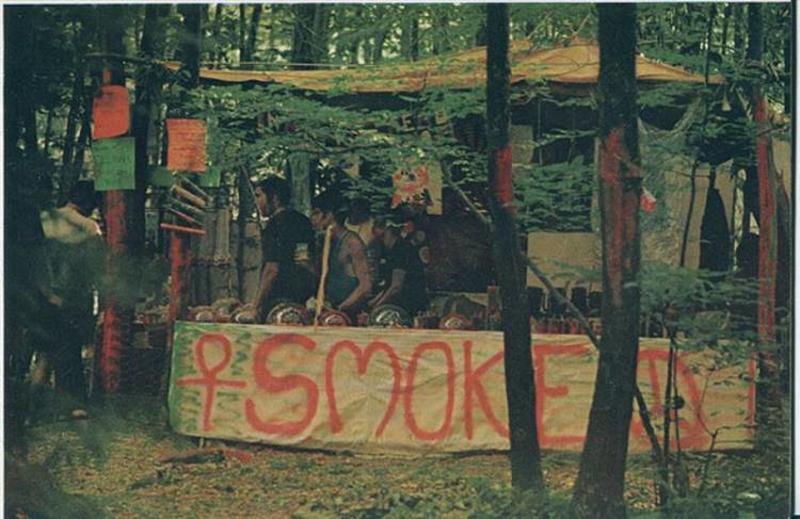
Smoke camps were designed to fit multiple people in and give them a communal space to bring their alcohol, share a joint, get to meet new people and socialize. The whole festival had an atmosphere of sharing and sociability, but it was sometimes nicer to take it all in a few people at a time rather than 400,000 people all together. People met in these smoke huts and formed friendships that lasted the rest of their lives. Others just popped in to hear an amusing anecdote before they set off to find the rest of their friends.
Let's take a moment to put together all of the little pieces of information we've given you with the other pictures and make a statement. Woodstock was awesome. There was no festival like it before, and there's never been one like it since. There almost certainly never will be. It was the right people inspired by the right things, all coming together to hear some of the greatest bands and performers who ever lived.
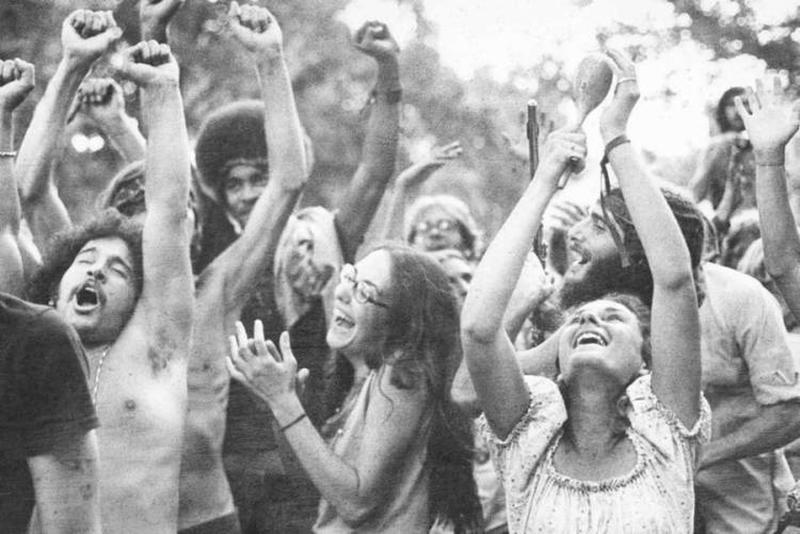
Anybody who got to see the event is truly lucky, and you should find someone and make them tell you everything they remember. The people in this final photo sum up the spirit of the festival best. They're people from all creeds and colors, and they're happy, laughing, dancing and united as one by the spirit of Woodstock. 1969. We can't think of a more perfect way to finish our list.